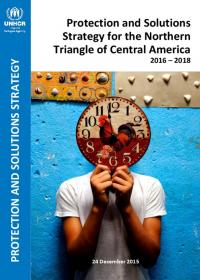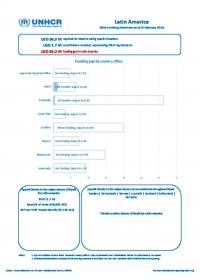Operations

OPERATIONS
Africa
- Central Africa and the Great Lakes
- Burundi
- Cameroon
- Central African Republic
- Congo
- Democratic Republic of the Congo
- Rwanda
- United Republic of Tanzania
- East and Horn of Africa
- Southern Africa
- West Africa
Americas
Asia and the Pacific
Europe
Middle East and North Africa
NEW: 2016 planning information has just been released. Budgets and population planning figures for 2016 and for previous years can be reviewed below. The French version is available in pdf format.
Location
{"longitude":-80,"latitude":8,"zoom_level":0}
Latest update of camps and office locations 13 January 2016. By clicking on the icons on the map, additional information is displayed.
Operational Highlights
Operational context and population trends
UNHCR’s Regional Office in Panama covers activities in Panama, the Northern Triangle of Central America (Honduras, El Salvador and Guatemala) and Cuba.
In December 2014, at a ministerial meeting in Brasilia, UNHCR and representatives of 28 countries and three territories in Latin America and the Caribbean adopted the Brazil Plan of Action, a road map to address new displacement trends and end statelessness by 2024. This road map aims to guide policy and strategy related to forced displacement, transnational criminal groups, access to and quality of RSD, durable solutions, mixed migration movements, and statelessness.
In the Northern Triangle of Central America (NTCA), transnational organized crime and rampant violence continue to pose a major challenge to democratic governance. Criminal activity, fuelled by drug trafficking, weak law enforcement, poverty and unemployment, are also exacerbating the current protection crisis.
Population trends in Central America have changed dramatically in the last years, creating a particularly challenging environment in the NTCA. In 2014 alone, 29,024 requests for asylum were presented worldwide from citizens of NTCA countries.
According to the latest figures made available by migration authorities in 2014, more than 226, 377 people from Central America were deported. This represents a 78% rise in the number of individuals deported between 2011 and 2014. Many have left their countries due to a variety of reasons, including migration; however the Office has noted an increase in the number of people whose lives are at risk and are consequently in need of international protection. In studies such as Children on the Run and Arrancados de Raíz, at least 48% of the unaccompanied children and adolescents interviewed have indicated that they fled their countries due to violence and are therefore in need of international protection.
In Honduras, the Government officially launched an IDP profiling report in November 2015, which revealed that between 2004 and 2014, close to 41,000 households (around 174,000 individuals) in Honduras were affected by internal displacement due to violence and insecurity.
A similar profiling exercise is foreseen in El Salvador to measure the magnitude of forced displacement in the country.
In Panama, UNHCR assisted 2,369 people in 2014, an increasing number of which were asylum-seekers coming from the NTCA.
In Cuba, the refugee population originates mainly from Western Sahara and is projected to make-up 69% of the total in 2015.
Key priorities in 2016
In line with the Brazil Plan of Action, UNHCR’s priorities in 2016 are to:
UNHCR’s Regional Office in Panama covers activities in Panama, the Northern Triangle of Central America (Honduras, El Salvador and Guatemala) and Cuba.
In December 2014, at a ministerial meeting in Brasilia, UNHCR and representatives of 28 countries and three territories in Latin America and the Caribbean adopted the Brazil Plan of Action, a road map to address new displacement trends and end statelessness by 2024. This road map aims to guide policy and strategy related to forced displacement, transnational criminal groups, access to and quality of RSD, durable solutions, mixed migration movements, and statelessness.
In the Northern Triangle of Central America (NTCA), transnational organized crime and rampant violence continue to pose a major challenge to democratic governance. Criminal activity, fuelled by drug trafficking, weak law enforcement, poverty and unemployment, are also exacerbating the current protection crisis.
Population trends in Central America have changed dramatically in the last years, creating a particularly challenging environment in the NTCA. In 2014 alone, 29,024 requests for asylum were presented worldwide from citizens of NTCA countries.
According to the latest figures made available by migration authorities in 2014, more than 226, 377 people from Central America were deported. This represents a 78% rise in the number of individuals deported between 2011 and 2014. Many have left their countries due to a variety of reasons, including migration; however the Office has noted an increase in the number of people whose lives are at risk and are consequently in need of international protection. In studies such as Children on the Run and Arrancados de Raíz, at least 48% of the unaccompanied children and adolescents interviewed have indicated that they fled their countries due to violence and are therefore in need of international protection.
In Honduras, the Government officially launched an IDP profiling report in November 2015, which revealed that between 2004 and 2014, close to 41,000 households (around 174,000 individuals) in Honduras were affected by internal displacement due to violence and insecurity.
A similar profiling exercise is foreseen in El Salvador to measure the magnitude of forced displacement in the country.
In Panama, UNHCR assisted 2,369 people in 2014, an increasing number of which were asylum-seekers coming from the NTCA.
In Cuba, the refugee population originates mainly from Western Sahara and is projected to make-up 69% of the total in 2015.
Key priorities in 2016
In line with the Brazil Plan of Action, UNHCR’s priorities in 2016 are to:
- Support countries of origin in designing and implementing legal frameworks and national policies.
- Establish protection networks in order to identify, refer, document and respond to the specific needs of people of concern;
- Strengthen asylum systems and ensure that people in need of international protection have access to fair, efficient and age, gender and diversity-sensitive asylum systems in countries of asylum and transit and are protected from refoulement.
- Ensure that the basic protection needs of children and other people with specific needs are accurately identified and addressed (including unaccompanied and separated children, as well as other groups with specific protection needs such as LGBTI persons, survivors of sexual and gender-based violence, victims of trafficking, indigenous people and afro descendants).
- Increase awareness among stakeholders to ensure visibility of the protection risks of people of concern and enhance mobilization of resources;
- Promote access to different solutions scenarios for refugees and other people of concern.
Stories
People of Concern
3%
Increase in
2014
2014
| 2014 | 19,663 |
| 2013 | 19,152 |
| 2012 | 18,534 |

[["Refugees",3056],["Refugee-like situation",15000],["Asylum-seekers",1597],["Returned refugees",5],["Stateless",3],["Others of concern",2]]
Loading ...
Budgets and Expenditure for Regional Office Panama
< Back
2014
{"categories":[2012,2013,2014,2015,2016],"budget":[5.12996089,5.8548486,8.42523081,10.21795595,12.20593607],"expenditure":[3.74483435,4.03032947,4.45055113,null,null]}
{"categories":[2012,2013,2014,2015,2016],"p1":[5.12996089,5.69669732,8.10063207,9.66598137,12.20593607],"p2":[null,0.15815128,0.32459874,0.55197458,null],"p3":[null,null,null,null,null],"p4":[null,null,null,null,null]}
{"categories":[2012,2013,2014,2015,2016],"p1":[3.74483435,3.87217783,4.28218306,null,null],"p2":[null,0.15815164,0.16836807,null,null],"p3":[null,null,null,null,null],"p4":[null,null,null,null,null]}
Loading ...




